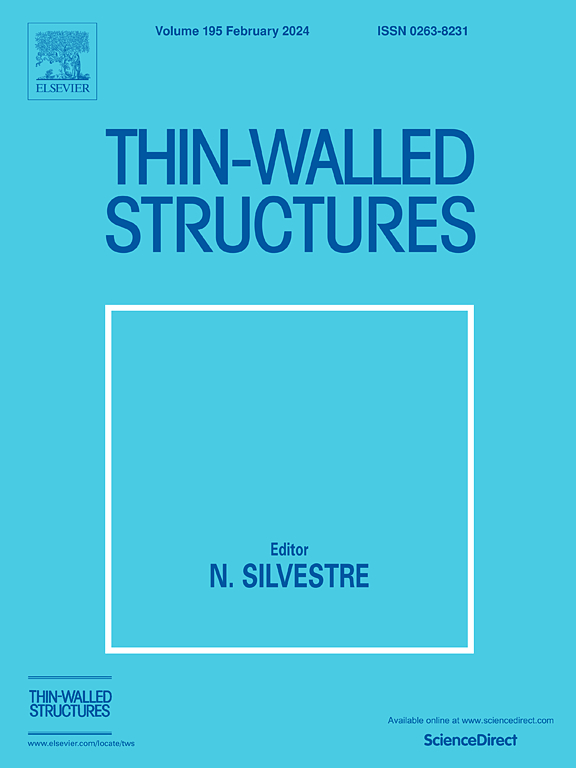A novel joining technology for hybrid busbars in electric vehicle batteries
IF 5.7
1区 工程技术
Q1 ENGINEERING, CIVIL
引用次数: 0
Abstract
In this paper, a joining by forming technique is suggested to join aluminium and copper sheets, aimed at potential hybrid busbar manufacturing. The technique, called hole hemming, is performed through the deformation of the aluminium sheet to create a mechanical interlock with the copper sheet, requiring neither heat, welding, nor additional elements/materials. Initially, the feasibility of this joining process is assessed using an analytical model to determine the parameters required for achieving a mechanical interlock while avoiding fractures. The accuracy of the process windows developed by this model is validated through comparisons with experimental results and numerical simulations. In these simulations, the Modified Mohr-Coulomb criterion is employed to predict ductile damage. Furthermore, a new design incorporating branches in the aluminium sheet holes is introduced. This innovation allows for fracture-free joint manufacturing beyond the safe limits predicted by the analytical model, thereby expanding the range of feasible process parameters. Subsequently, the mechanical performance of joints with and without branches is evaluated through destructive shear and cross-tension tests at both room temperature and an elevated temperature of 120 °C, simulating the maximum service conditions for busbars. The results demonstrate that hole hemming effectively joins AA6082-T4 and Cu-ETP R240 sheets, validating the proposed designs. Specifically, the hybrid aluminium and copper joints exhibit a maximum shear strength of 4.35 kN and a displacement of 12.11 mm at room temperature. In cross-tension tests, the joints achieve a maximum strength of 1.73 kN and a displacement of 9.86 mm. Although performance slightly diminishes at elevated temperatures, it remains excellent for both destructive test configurations.
电动汽车电池中混合动力母线的新型连接技术
本文提出了一种通过成型连接铝板和铜板的技术,旨在实现潜在的混合母线制造。该技术被称为 "折边孔",通过铝板变形与铜板形成机械互锁,既不需要加热、焊接,也不需要额外的元件/材料。最初,我们使用一个分析模型来评估这种连接工艺的可行性,以确定在避免断裂的同时实现机械互锁所需的参数。通过与实验结果和数值模拟的比较,验证了该模型开发的工艺窗口的准确性。在这些模拟中,采用了修正的莫尔-库仑准则来预测韧性损伤。此外,还介绍了一种在铝板孔中加入分支的新设计。这一创新使接头制造的无断裂性能超出了分析模型预测的安全极限,从而扩大了可行工艺参数的范围。随后,通过在室温和 120 °C 高温下进行破坏性剪切和交叉拉伸试验(模拟母线的最大使用条件),评估了带分支和不带分支接头的机械性能。结果表明,孔对折能有效连接 AA6082-T4 和 Cu-ETP R240 板材,验证了所提出的设计。具体来说,铝铜混合接头在室温下的最大剪切强度为 4.35 kN,位移为 12.11 mm。在交叉拉伸试验中,接头的最大强度为 1.73 千牛,位移为 9.86 毫米。虽然在温度升高时性能略有下降,但在两种破坏性测试配置中仍然表现出色。
本文章由计算机程序翻译,如有差异,请以英文原文为准。
求助全文
约1分钟内获得全文
求助全文
来源期刊

Thin-Walled Structures
工程技术-工程:土木
CiteScore
9.60
自引率
20.30%
发文量
801
审稿时长
66 days
期刊介绍:
Thin-walled structures comprises an important and growing proportion of engineering construction with areas of application becoming increasingly diverse, ranging from aircraft, bridges, ships and oil rigs to storage vessels, industrial buildings and warehouses.
Many factors, including cost and weight economy, new materials and processes and the growth of powerful methods of analysis have contributed to this growth, and led to the need for a journal which concentrates specifically on structures in which problems arise due to the thinness of the walls. This field includes cold– formed sections, plate and shell structures, reinforced plastics structures and aluminium structures, and is of importance in many branches of engineering.
The primary criterion for consideration of papers in Thin–Walled Structures is that they must be concerned with thin–walled structures or the basic problems inherent in thin–walled structures. Provided this criterion is satisfied no restriction is placed on the type of construction, material or field of application. Papers on theory, experiment, design, etc., are published and it is expected that many papers will contain aspects of all three.
 求助内容:
求助内容: 应助结果提醒方式:
应助结果提醒方式:


